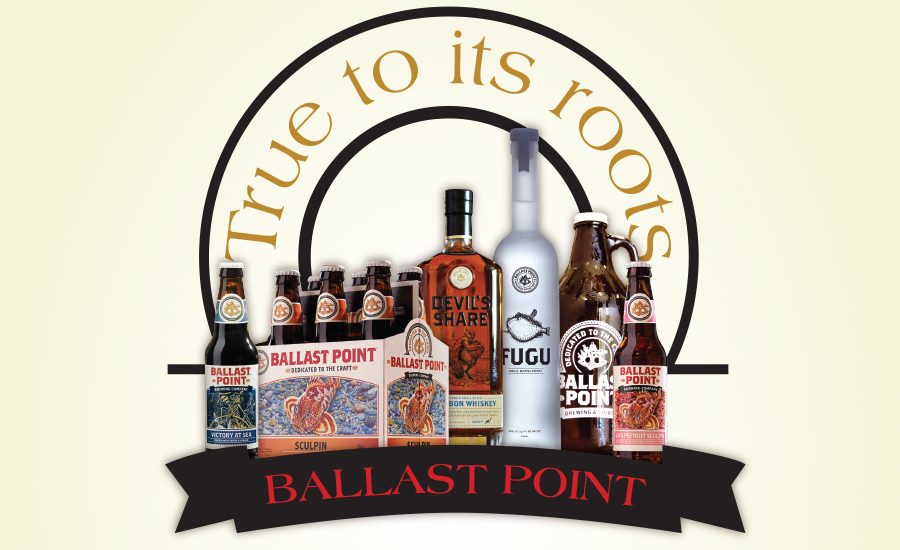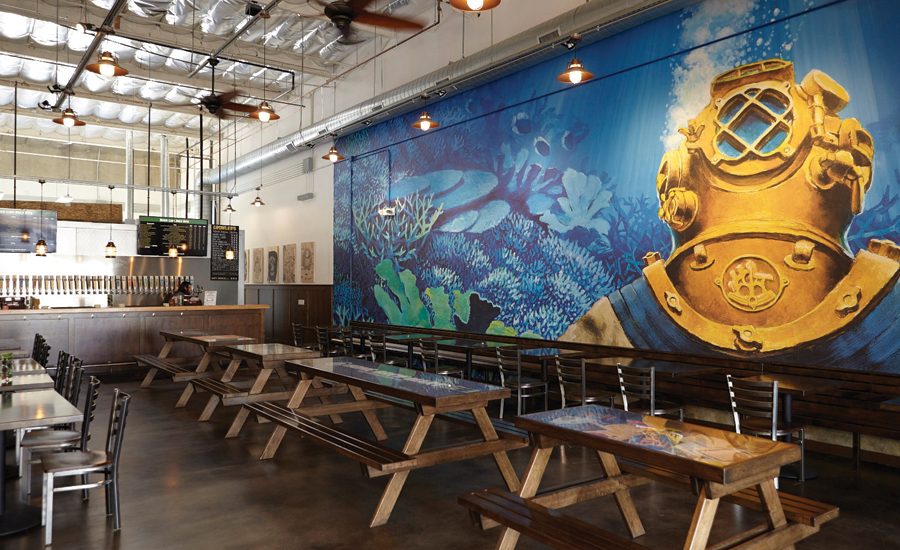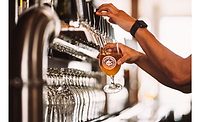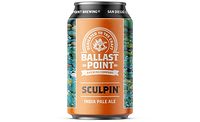Ballast Point stays true to its homebrewing roots
Craft brewer and distiller celebrates 20th anniversary


Ballast Point was born from a “backroom brewery” in Home Brew Mart, a shop that supplies homebrewers with tools and ingredients for homebrewing. (Image courtesy of SchulzStudio/Ballast Point Brewing and Spirits)

Sculpin IPA is the craft brewer’s most successful SKU. The beer features hops that create hints of apricot, peach, mango and lemon flavors. (Image courtesy of SchulzStudio/Ballast Point Brewing and Spirits)

The Devil’s Share portfolio, which features Bourbon Whiskey, Single Malt Whiskey and Moonshine, is among the top performers in Ballast Point Spirits. (Image courtesy of SchulzStudio/Ballast Point Brewing and Spirits)

All of Ballast Point’s locations feature tasting rooms for its beers. The Temecula location is the first that will not feature brewing capabilities. (Images courtesy of StudioSchulz/Ballast Point Brewing and Spirits)





Innovation and exploration, those are the influences behind the plethora of craft beers and spirits that Ballast Point Brewing & Spirits develops, Chief Commercial Officer Earl Kight says. Noting the San Diego-based craft brewery and distillery has between 27-30 packaged beers, more than 100 draft beers and about 21 spirits within its portfolio, Kight notes that ambitious spirit is how the company sets the stage for new product development.
“We don’t sit back and say ‘Oh, we believe the next trend is going to be X, Y or Z,’” he says. “I think we kind of start the trends because of our creativity, so you end up with products like Grapefruit Sculpin, Pineapple Sculpin or Sculpin itself. We have a [research and development] R&D brew house in one of our restaurants where we brew a different beer almost every day led by teams of our employees.”
Although Ballast Point has its R&D teams, the ideation for its beers and spirits stems from the company’s homebrewing origination. “It’s real simple, it’s the homebrewing roots,” Kight says. “If you’re a homebrewer, you’re not going to go and make IPAs all the time. You’re creative and you want to explore. If you’re curious about how to make a lager, you want to make a killer IPA, you want to somehow figure out how to make an imperial stout, you want to explore with other flavors, that’s really the essence where all this comes from. We make award-winning IPAs, lagers, stouts, porters. You name it, we’re across the board.”
Where it all began
Those homebrewing roots date back to 1992 when Ballast Point’s Founder Jack White opened Home Brew Mart, a shop that supplies homebrewers with the tools and ingredients they need to brew their own beer.
With his college roommate Pete A’Hearn, who obtained a master brewer’s certificate, and collaboration from Yuseff Cherney, another homebrewer, White eventually was able to take Home Brew Mart to the next level by adding a “backroom brewery” to the shop. By 1996, Ballast Point Brewing was born.
“[Home Brew Mart] allowed us to have a staging ground for the brewery, and it also gave us these homebrewing roots, which we still go back to,” Kight says.
But the company didn’t limit itself to beer. Between 2007 and 2008, Cherney suggested the brewery explore distilling. “The mindset was it was the next logical step in the science of brewing,” Kight explains. “You start off as homebrewers, you become award-winning homebrewers, you launch a commercial brewery, an award-winning commercial brewery, and, in our mind, the next step was to become a distillery.”
Now 20 years removed from the launching of Ballast Point, the company has seen the fruits of its labor flourish as it continues to expand its brick-and-mortar operations. But even with those expansions, it remains true to where it began, Kight says. “Pretty much everything has stayed the same,” he notes. “The goal of our company is we brew and we distill things that we like to drink and we hope that our customers do also, so we’ve stayed really true to that. We’ve added food into that mix. We own three restaurants now. If you step back and think about it, we try to brew, distill and deliver food that we like to eat.”
In 2015, Ballast Point’s success garnered the attention of Victor, N.Y.-based Constellation Brands Inc. Constellation acquired the craft brewery and distillery to enable it to compete in the craft beer market. Although the acquisition allows Ballast Point access to Constellation’s financial position and willingness to invest in growth, the company continues to operate as a standalone business.
“We started this business nearly 20 years ago with a vision to produce great beer that consumers love and to do it the right way,” White said in a statement in November 2015. “To achieve that vision, we needed to find the right partner. The team at Constellation shares our values, entrepreneurial spirit and passion for beer, and has a proven track record of helping successful premium brands reach the next level of growth and scale.”
Because Ballast Point is treated as an independent business, not much has changed at the company, Kight explains.
“We make the decisions of what we’re brewing,” he says. “None of our recipes changed. We’re making the decisions on our distributor relationships. We have our own national account teams and sales rep teams. … The reality is [that] nothing’s really changed.”
With the core of its brewing and distilling process unfazed by the acquisition, Ballast Point is gearing up for its 20th anniversary. In celebration of this milestone, the company will pay homage to its start with the Ballast Point Original Gravity 20th Anniversary Homebrew Competition, a nationwide homebrewing contest that rolled out at the end of February. Homebrewers interested in competing can visit ballastpoint.com/OG20 for more information.
Room to grow
As depicted in the 1976 Schoolhouse Rock! song “Elbow Room,” “it’s nice when you’re cozy, but not when you’re tangled nose to nosey, oh everybody needs some elbow, needs a little elbow room.”
Although the educational children’s song was describing Thomas Jefferson’s Louisiana Purchase in 1803, the notion of expansion is one that Ballast Point has embraced. The craft brewery and distillery might have started in the back of Home Brew Mart — which houses a 20-barrel brew house that manufactures specialty beers and features a tasting room — but since then has added four other points of operation.
The craft brewer and distiller’s next endeavor was Scripps Ranch, also within the city limits of San Diego. At 23,000 square feet, this facility contains a 50-barrel brew house that operates 24/7 and produces 100,000 barrels of beer a year. It also is the headquarters for Ballast Point Spirits and the distilling operations.
Following Scripps Ranch, Ballast Point Tasting Room and Kitchen opened. Located in Little Italy in San Diego, Ballast Point Brewing and Kitchen has a 5-barrel brew house that focuses on experimental beers as well as a restaurant.
In 2014, the company opened its largest operation: Miramar. Complete with a 150-barrel copper brew house that was transported from Lohr, Germany, Miramar is more than 107,000 square feet and houses a 570-seat restaurant.
And, for the first time in its history, Ballast Point opened an operation that doesn’t have brewing capabilities. In early February, a tasting bar and kitchen opened in Temecula, Calif.
“Temecula is really about making a smaller venue than we have [in] our other locations and allowing folks to get some beers that they couldn’t [get] unless they came to San Diego,” Kight says. “With the portfolio that we have, people will be on social media and say, ‘Geez if I could only taste Coconut Victory at Sea or Barrel Aged Sea Monster Stout.’ We don’t package that stuff. The only way you’re going to get it in a growler [is] if you come to San Diego. Temecula is our first location that [doesn’t] have brewing capability, but it offers people a chance to go in and taste our vast portfolio of beers.”
Simple idea
When it comes to new product development, Kight says Ballast Point’s team keeps to a simplistic principle: brew and distill what they want to drink. This has allowed the company to develop numerous award-winning and consumer-pleasing alcohol drinks.
Although California Kölsch, formerly known as Pale Ale The Original — a 5.2 percent alcohol-by-volume (ABV) brew featuring German hops and a blend of American and Munich malts — is the popular beer that launched Ballast Point, Sculpin IPA has emerged as the company’s most successful SKU, Kight notes. At 7 percent ABV, Sculpin IPA features hops that create hints of apricot, peach, mango and lemon flavors, the company says.
Its popularity also has inspired the brewers to develop other varieties of the IPA like Grapefruit Sculpin and Pineapple Sculpin, which launched in January. The packaging of Grapefruit Sculpin, however, was not a planned release but rather a pleasant happenstance.
“Grapefruit Sculpin is a story I tell everyone about how a beer, by accident, got in a package,” Kight explains. “We had a buyer from a large chain in one of our tasting bars. We used to only make this beer on draft, and this individual tasted it in May 2014. The buyer said, ‘You know what, if you can put that in a six-pack I can put in about 300-400 stores.’
“By September, we had figured out how to scale it up,” he continues. “We brewed and packaged our first eight pallets in early September. We sold all eight pallets in our tasting bars over a weekend. Four-hundred and eighty cases in a weekend.”
Citing data from Chicago-based Information Resources Inc., Kight says Grapefruit Sculpin is San Diego’s second-largest craft brand behind only Sculpin.
Although Pineapple Sculpin’s packaging wasn’t by happenstance, the newly packaged IPA is having similar success to Grapefruit Sculpin’s early sales, Kight adds.
In addition to Pineapple Sculpin, the company recently released Watermelon Dorado, a 10 percent ABV double IPA, and Mango Even Keel Session IPA. Kight notes that Mango Even Keel is a true session IPA as it has only a 3.8 percent ABV versus others that might be in the 4.5-4.7 range.
This summer, Ballast Point also has plans to package Sour Wench Blackberry Ale, a brew that it has been producing for years, but was only available on draft. The draft portfolio has served as an influencer for the company when rolling out new packaged beers, Kight says.
“Every once in a while we look at our draft portfolio and we’ll make a comment like, ‘Wow, we really should package that beer,’” he says.
But before a beer makes it on draft or in a package, the executives at Ballast Point are turning to their R&D teams. “Our R&D efforts are pretty over-the-top,” Kight explains. “We’ve got an entire R&D program at our Little Italy location where we have a 5-barrel brew house where we use teams of our employees. We vote on these brands, and we try to bring to life the ones that we really like.
“A couple of them have done it,” he continues. “We have to take a look at it and say, ‘If you’re going to make something, is it going to be commercially viable?’ Our beer’s expensive to begin with, but do we want to come up with something that’s made with a hop that’s only picked on Tuesdays in the eastern side of Tahiti so you can only make 5 barrels a year?”
Homebrewing recipes also continue to have an impact on packaged beers. Kight recalls a request the company received from a retailer that wanted a beer that was exclusive to them. However, laws prohibit such a practice, he explains.
The team at Ballast Point still wanted to find a solution for the retailer. And from there, the ideation of Homework Series was born.
“We have two different licenses,” Kight says. “We have Ballast Point and one with Home Brew Mart. We said, ‘What happens if you make a beer under the Home Brew Mart label and you put the recipe on the outside of the label?’ We took the homebrewers recipe from one of our brewers and we scaled it down so that somebody can make a 5-gallon batch, so they can buy the beer.
“They then can go buy the ingredients and see if they can duplicate the beer,” he continues. “We do it maybe two or three times a year. It started off as a one-off. We were just going to do it once and it’s taken on a life of its own, but it’s really just going back to the homebrewing roots.”
Similar to its beer portfolio, the company’s spirits portfolio also falls in line with its original roots. “A lot of ideas come from Yuseff Cherney and his couple of guys he distills with,” Kight says. “Once again, it comes down to an idea that somebody has and then they bring it to life. We don’t go out and do a focus group; we don’t look at the trends of society.”
For example, Opah, an herbal liqueur that recently was added to the portfolio, is a balance of licorice and hot and spicy flavors, Kight explains, and was the brain child of White. “It really came from Jack sitting back one day saying, ‘Wouldn’t it be cool if we made a liqueur that tasted like this?’ And then we just started experimenting,” he says.
When it comes to the top performers within Ballast Point Spirits, Kight says the brown spirits — whiskey and bourbon — are popular with consumers. “The problem is we can’t make it fast enough,” he says. “We can’t make it age quicker than it has to be aged.”
With an aging period of at least three years, Devil’s Share Single Malt Whiskey and Devil’s Share Bourbon are both award-winning spirits for the company. But they aren’t the only shining stars within the spirits group.
“Our gin is very popular,” Kight says. “We do some canned cocktails, which we have [Fugu] Bloody Mary, [Old Grove] Gin & Tonic, [Three Sheets] Rum & Ginger, and [Three Sheets] Rum & Cola that are actually made with spirits and we make them on a canning line, so pre-mixed craft spirits.”
Artfully designed
With how much attention is put into the brewing and distilling process, the same was put into naming the company, the products and designing the labels.
Kight explains that before Ballast Point opened, White was intending to name the company Sequoia Brewing Co. However, with no sequoias within the San Diego city limits, White decided to go in another direction and headed to the historical society to find inspiration.
After looking at maps, he was drawn to Ballast Point, a harbor in a peninsula in the San Diego Bay. The harbor got its name because when ships would arrive in the harbor to drop off goods in the 1800s, they used rocks from the area to serve as the ballast of the ships when departing, Kight explains. The rocks were necessary because, at the time, San Diego only received goods so the ships were much lighter when they left, he adds.
With a company name that paid homage to the harbor, Cherney suggested using game fish that are caught off of San Diego on the labels. While the founders were discussing this plan in Home Brew Mart’s tasting bar, Paul Elder, a local artist, overheard the conversation.
“A guy speaks up from the back and says, ‘Hey, I’m an artist, and I paint fish, and I’ve got my sketchbook out in my car if you’d like to take a look,’” Kight explains.
It was there that company decided to forge a partnership with Elder, who now is a full-time employee of Ballast Point and continues to draw all of its labels. “Paul is priceless,” Kight says. “He really does a great job for us.”
Although the idiom says “there are plenty more fish in the sea,” it is not true for Ballast Point. With such a vast portfolio, the company seems to have run the gamut on game fish and has collaborated with Elder on other ways to keep with the nautical theme.
“Some of our labels, you’ll notice, we’ve been doing a lot of skeletons, primarily because Paul can’t paint people. We were running out of fish and we didn’t know what to do,” Kight says. “So we went down the road with pirates and such.”
But whether named for a fish or a pirate myth, Kight says distributors, retailers and consumers can look forward to more from brews, spirits and distribution points from Ballast Point. Currently available in 37 states and seven countries, Ballast Point has plans to complete its national distribution.
“We’ll be in all 50 states by the end of the year,” Kight says.
Looking for a reprint of this article?
From high-res PDFs to custom plaques, order your copy today!












